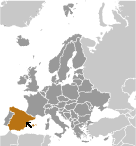World Atlas: Spain. On this page you can see the map, country flag and many detailed information about the people, history and economy of Spain.

Here you can find online selected information about the geography, inhabitants, government, economy and history of Spain. Included are selected statistics, an overview map and the detailed map of Spain. But let's start with the flag of Spain here:
Spain - Overview:
What you should know about Spain? Let's start with this: Spain's powerful world empire of the 16th and 17th centuries ultimately yielded command of the seas to England. Subsequent failure to embrace the mercantile and industrial revolutions caused the country to fall behind Britain, France, and Germany in economic and political power. Spain remained neutral in World War I and II but suffered through a devastating civil war (1936-39). A peaceful transition to democracy following the death of dictator Francisco Franco in 1975, and rapid economic modernization (Spain joined the EU in 1986) gave Spain a dynamic and rapidly growing economy and made it a global champion of freedom and human rights. More recently Spain has emerged from a severe economic recession that began in mid-2008, posting three straight years of GDP growth above the EU average. Unemployment has fallen, but remains high especially among youth. Spain is the Eurozone’s fourth largest economy.
Geography of Spain
 Where on the globe is Spain? The location of this country is Southwestern Europe, bordering the Mediterranean Sea, North Atlantic Ocean, Bay of Biscay, and Pyrenees Mountains; southwest of France. Total area of Spain is 505,370 sq km, of which 498,980 sq km is land. So this is quite a large country. How could we describe the terrain of the country? This way: large, flat to dissected plateau surrounded by rugged hills; Pyrenees Mountains in north. The lowest point of Spain is Atlantic Ocean 0 m, the highest point Pico de Teide (Tenerife) on Canary Islands 3,718 m. And the climate is temperate; clear, hot summers in interior, more moderate and cloudy along coast; cloudy, cold winters in interior, partly cloudy and cool along coast.
Where on the globe is Spain? The location of this country is Southwestern Europe, bordering the Mediterranean Sea, North Atlantic Ocean, Bay of Biscay, and Pyrenees Mountains; southwest of France. Total area of Spain is 505,370 sq km, of which 498,980 sq km is land. So this is quite a large country. How could we describe the terrain of the country? This way: large, flat to dissected plateau surrounded by rugged hills; Pyrenees Mountains in north. The lowest point of Spain is Atlantic Ocean 0 m, the highest point Pico de Teide (Tenerife) on Canary Islands 3,718 m. And the climate is temperate; clear, hot summers in interior, more moderate and cloudy along coast; cloudy, cold winters in interior, partly cloudy and cool along coast.
Inhabitants of Spain
Let's take a look how many people live in Spain. The number is: 48,958,159 (July 2017 est.). So quite a lot people live here. Who lives here? composite of Mediterranean and Nordic types. What are the languages in Spain? Castilian Spanish (official nationwide) 74%, Catalan (official in Catalonia, the Balearic Islands, and the Valencian Community (where it is known as Valencian)) 17%, Galician (official in Galicia) 7%, Basque (official in the Basque Country and in the Basque-speaking area of Navarre) 2%, Aranese (official in the northwest corner of Catalonia (Vall d'Aran) along with Catalan, . And the religions: Roman Catholic 67.8%, atheist 9.1%, other 2.2%, non-believer 18.4%, unspecified 2.5% (2016 est.). How old are the people in average? 42.7 years. We have to add that this number is the median - so one half of the people is older than this, one half is younger. And what is their life expectancy (at birth)? This: 81.8 years. Where the people live in Spain? Here: with the notable exception of Madrid, Sevilla, and Zaragoza, the largest urban agglomerations are found along the Mediterranean and Atlantic coasts; numerous smaller cities are spread throughout the interior reflecting Spain's agrarian heritage; dense settlement is found around the capital of Madrid, as well as the port city of Barcelona. The major urban areas of Spain are: Madrid (capital) 6.199 million; Barcelona 5.258 million; Valencia 810,000 (2015).
Government and Economy of Spain
The capital of Spain is Madrid and the government type parliamentary constitutional monarchy. Let's take a look at the administrative divisions - 17 autonomous communities (comunidades autonomas, singular - comunidad autonoma) and 2 autonomous cities (ciudades autonomas, singular - ciudad autonoma); Andalucia; Aragon; Asturias; Canarias (Canary Islands); Cantabria; Castilla-La Mancha; Castilla-Leon; Cataluna (Castilian), Catalunya (Catalan), Catalonha (Aranese) [Catalonia]; Ceuta; Comunidad Valenciana (Castilian), Comunitat Valenciana (Valencian) [Valencian Community]; Extremadura; Galicia; Illes Baleares (Balearic Islands); La Rioja; Madrid; Melilla; Murcia; Navarra (Castilian), Nafarroa (Basque) [Navarre]; Pais Vasco (Castilian), Euskadi (Basque) [Basque Country]. Regarding the economy of Spain, important industrial products are textiles and apparel (including footwear), food and beverages, metals and metal manufactures, chemicals, shipbuilding, automobiles, machine tools, tourism, clay and refractory products, footwear, pharmaceuticals, medical equipment. Important agricultural products are grain, vegetables, olives, wine grapes, sugar beets, citrus; beef, pork, poultry, dairy products; fish. The most important export commodities are machinery, motor vehicles; foodstuffs, pharmaceuticals, medicines, other consumer goods and the most important export partners are France 15.2%, Germany 11.4%, Italy 7.8%, UK 7.6%, Portugal 7%, US 4.4% (2016). The most important import commodities are machinery and equipment, fuels, chemicals, semi-finished goods, foodstuffs, consumer goods, measuring and medical control instruments and the most important import partners are Germany 14.7%, France 12%, China 7.1%, Italy 6.7%, Netherlands 5.2%, UK 4.4% (2016). How rich is Spain and how rich are people in this country? The most important number here is GDP per capita (PPP): $38,200 (2017 est.). This means the living standards are good here. Let's add that this means Gross Domestic Product per person, which is recalculated with respect to the relative cost of local goods and services. And one more important number - population below poverty line: 21.1% (2012 est.).